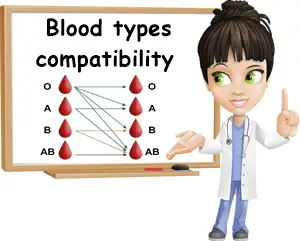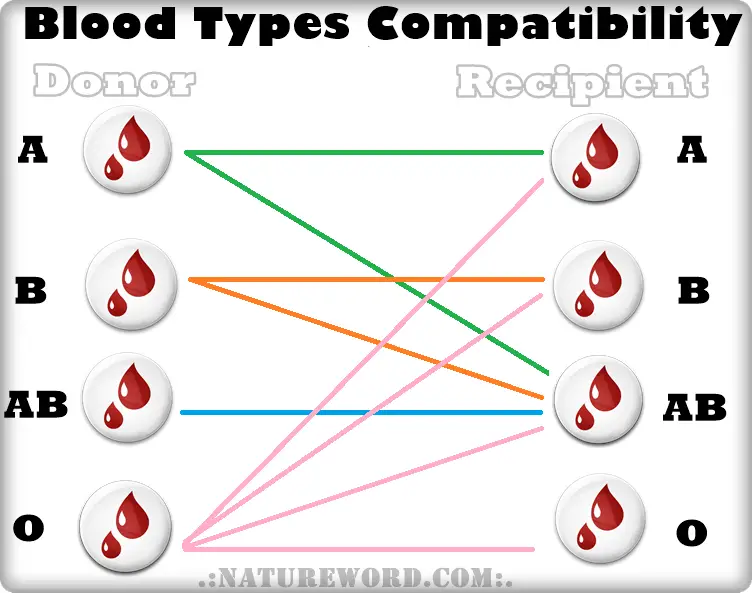Blood types or blood groups are essentially classifications of blood according to various cell markers. They are used for determining blood types compatibility for transfusions and transplants and even paternity, although not as exact as DNA testing. The two main blood group classifications are the ABO and the Rh blood types, both discovered by immunologist Karl Landsteiner in the first half of the 20th century. There are a total of around 35 different blood groups classifications that characterize blood according to more or less common cell markers.
ABO and Rhesus, Rh factor blood systems. The two main reference blood classification systems are the ABO and the Rhesus (Rh factor) classifications. They give the following blood groups: A, B, AB and O and respectively Rh negative and Rh positive variants of all four ABO types.
Blood composition (solids, plasma and serum). Blood is a fluid that runs through our veins and arteries. It’s made of solids and fluids. Solids include blood cells such as red blood cells, white blood cells and platelets. The liquid part of blood is called blood plasma and is a straw-yellow water-based fluid made up of sugar, proteins, amino acids, fatty acids, hormones, electrolytes, oxygen, carbon dioxide and clotting factors. Blood plasma without clotting factors is called blood serum.

What determines blood types? Essentially, blood types are determined based on the presence of specific cell markers called antigens on the surface of red blood cells and based on the occurrence or non-occurrence of antibodies for these cell markers in the blood serum.
What are blood antigens? Antigens are molecules made from chains of amino acids, simple sugars or lipids. In blood type classification, they represent distinct markers on the surface of red blood cells. These types of antigens are genetically determined, hence the reason why blood types are inherited from one’s parents and blood type determination is used for paternity testing.
What are alleles? In the context of blood groups, alleles are variants of the gene or genes that determine different blood types. For example, the ABO blood group is determined by a gene with three alleles, namely the isoagglutinogens or antigens i, IA and IB. These stand for the antigens for blood types O, A, B and the combination AB. The alleles or gene variants are inherited from both parents. A and B are dominant while O is recessive. This means that you would have to inherit a specific combination of alleles from both your parents to have type O blood, for example. A child can have blood type O if both parents have at least one gene for this blood type to pass on. Chances increase by 25% if a parent has two genes for blood type O and the other at least one. Two parents with blood type O and two genes for it each will most likely have a child with the same blood group.
What blood type do you have based on your parents?
Here are some examples:
– If you inherit IAIA (antigen A from one parent and antigen A from the other) or IAi (antigen A from one parent and antigen for type O from the other), your blood group will be type A.
– If you inherit IBIB or IBi, you will have blood type B.
– If you inherit IAIB, you can have blood type A, B or AB.
– If you inherit ii antigens, you will have blood type O.
– If one parent has blood type A with antigens IAi (for both type A and type O) and the other parent has blood type B with antigens IBi (for both type B and type O), the child can have blood type O, A, B or AB.
– And, of course, two parents with blood type O and two genes for it each (ii and ii) will almost certainly have a child with the same blood group (O with antigens ii).

What is Rh (Rhesus)?
Rh or Rhesus is a system that classifies blood groups based on the presence or absence of several cell markers, the most notable of which is the RhD antigen or D antigen, also referred to as Rh factor. Rh factor is genetically determined by inheriting different alleles (gene variants) from parents. It is the second most relevant blood type classification and vital for correctly determining blood compatibility. Two people with the same blood group in the ABO system and the same Rh are perfectly compatible. But because neither Rh- nor Rh+ types typically contain antibodies for the RhD antigen, Rh- blood can be donated to Rh+ recipients.
Rh factor is marked with the suffixes “-” or “+” which stand for:
– Rh negative (meaning without the D antigen): A-, B-, AB- and O-
– Rh positive (meaning with the D antigen): A+, B+, AB+ and O+
Any ABO blood type can be either Rh negative or Rh positive.
Blood compatibility between donor and recipient calls for the same ABO blood type and, ideally, the same Rh factor.
Rhesus factor and pregnancy. Incompatibility of Rh factor between mother and child can be dangerous during pregnancy. An Rh negative mother and an Rh positive father can have either and Rh negative or Rh positive child. If the mother is Rh- but the child is Rh+ it means the child has a D antigen that the mother doesn’t. If their blood comes into contact during pregnancy, the mother will produce antibodies against that antigen. These antibodies can reach the baby and attack its red blood cells carrying the D antigen marker, causing them to break down. Unless treated, this incompatibility causes what is known as hemolytic disease of the newborn and can result in a number of health problems and complications. The risk for the disease is low for first pregnancies, but high for second pregnancies.
What are blood antibodies?
Lastly, antibodies are immune system cells present in blood serum (the liquid part of blood without the blood cells and without clotting elements). They are essentially bigger Y-shaped proteins. Their purpose is to recognize harmful elements in the blood and eliminate them. They do so by recognizing specific cell markers (antigens) on the surface of cells. With regards to blood types, antibodies determine compatibility.
There are actually specific antibodies in each blood type across all systems of classification. One blood type will have antibodies for the specific antigens in another type, but not for the antigens in its own. For the ABO blood group system, antigens and antibodies occur in the following combinations:
Type A: has antigen A with antibody B
Type B: has antigen B with antibody A
Type AB: has antigens A and B and no antibodies for them
Type O (or zero): no antigens A or B, just antibodies A and B
Type Oh: In rare cases, type O has an antigen called H.
Below is a simple, non-Rh dependent ABO system compatibility figure.

Blood types compatibility: examples
A type A donor can give blood to a recipient with the same blood group because their antigens and antibodies are not the same (antigen A and antibody B). But a type A donor cannot give blood to a recipient with type B because the donor blood has antibodies for B antigens present in the recipient blood and these antibodies would destroy the red blood cells of the recipient.
A person with type AB can only give blood to someone with type AB because this particular blood group has both antigens A and B, and no antibodies for any of them. A type AB cannot receive blood from either type A or type B because a type AB requires a perfectly compatible blood type with both A and B antigens which are found only in AB blood, and no antibodies for said antigens (type A has only antigen A, and type B has only antigen B, and both type A and type B have antibodies for antigens B and A). A person with type O can donate to all other blood groups because of its lack of antigens.
Also, Rh factor must match: Rh- positive can donate to Rh- and Rh+, while Rh+ can only donate to Rh+.
What blood types match and what blood types can donate to other blood types? Compatibility is possible if the donor has antigens to match those in the recipient, but no antibodies for the antigens in the recipient blood. Compatibility is also determined by Rh and ideally requires the Rh factor to match in donor and recipient, although Rh negative types can donate to Rh positive types.
Blood types compatibility is as follows:
– Type A- can donate to type A- and AB-
– Type A+ can donate to type A+ and AB+
– Type B- can donate to type B- and AB-
– Type B+ can donate to type B+ and AB+
– Type AB- can donate to type AB-
– Type AB+ can donate to type AB+
– Type O+ can donate to type A+, B+, AB+ and O+
– Type O- can donate to types O-, O+, A-, A+, B-, B+, AB- and AB+
Frequently asked questions
1) Which blood type is the universal donor? Type O- (type O with Rh negative) is considered the universal donor because it can donate to all other blood groups, but can receive blood only from type O-.
2) Which blood type is the universal recipient? Type AB+ (AB with Rh positive) is considered the universal recipient because it can technically receive blood from all other blood groups, but can only donate to AB+. However, sensitization can occur at any point and antibodies for RhD antigen in Rh+ can develop (an example). Different other cross-reactions may occur. There are also rare blood types which contradict the concepts of universal donor and recipient.
3) What is the rarest blood type? Actually, the rarest blood type is AB-, followed by B-, A-, O- and AB+.
4) What blood type is the most common? Surprisingly, the most common blood type is O+, followed by A+ and B+.
